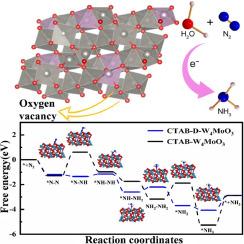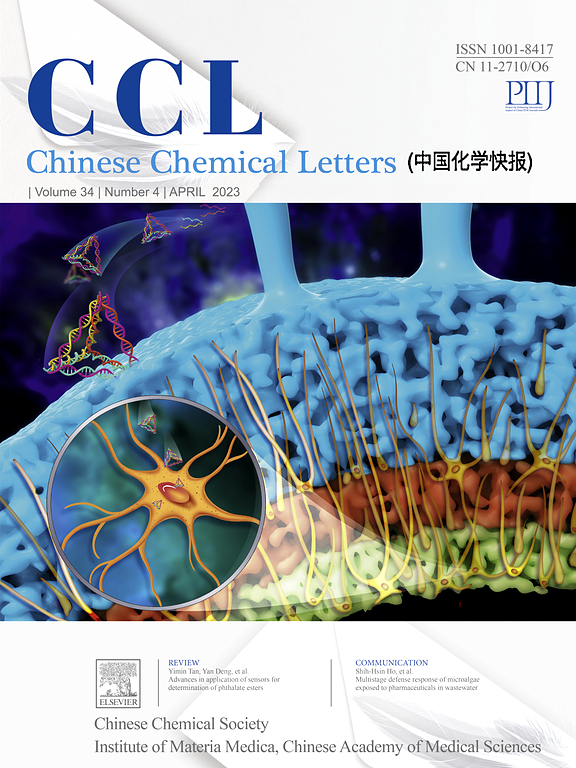富氧空位钼钨氧化物纳米线作为高活性固氮电催化剂
IF 9.4
1区 化学
Q1 CHEMISTRY, MULTIDISCIPLINARY
引用次数: 0
摘要
本文合理利用空位工程技术,探索将富含 O 空位的钼钨氧化物纳米线(W4MoO3 NWs)作为先进的电化学氮还原反应(eNRR)电催化剂,实现氮还原反应性能的进一步提高。在 0.1 mol/L Na2SO4 中,富含 O 空位的 W4MoO3 NWs(CTAB-D-W4MoO3)在 -0.70 V 对 RHE 时的 NH3 产率高达 60.77 µg h-1 mg-1cat.,在 -0.60 V 时的远化效率高达 56.42 %,远优于缺乏氧空位的 W4MoO3 NWs(在 -0.70 V 对 RHE 时的产率为 20.26 µg h-1 mg-1cat.)同时,富含氧空位的 W4MoO3 NWs 也表现出很高的电化学稳定性。密度泛函理论(DFT)计算表明,CTAB-D-W4MoO3 中的 O 空位降低了 *N-NH 中间体形成的能障,有利于 *N-N 的活化和进一步氢化,促进了 NRR 过程,提高了 NRR 活性。本文章由计算机程序翻译,如有差异,请以英文原文为准。

Oxygen vacancies-rich molybdenum tungsten oxide nanowires as a highly active nitrogen fixation electrocatalyst
Herein, vacancy engineering is utilized reasonably to explore molybdenum tungsten oxide nanowires (W4MoO3 NWs) rich in O-vacancies as an advanced electrochemical nitrogen reduction reaction (eNRR) electrocatalyst, realizing further enhancement of NRR performance. In 0.1 mol/L Na2SO4, W4MoO3 NWs rich in O vacancies (CTAB-D-W4MoO3) achieve a large NH3 yield of 60.77 µg h-1 mg-1cat. at -0.70 V vs. RHE and a high faradaic efficiency of 56.42 % at -0.60 V, much superior to the W4MoO3 NWs deficient in oxygen vacancies (20.26 µg h-1 mg-1cat. and 17.1 % at -0.70 V vs. RHE). Meanwhile, W4MoO3 NWs rich in O-vacancies also show high electrochemical stability. Density functional theory (DFT) calculations present that O vacancies in CTAB-D-W4MoO3 reduce the energy barrier formed by the intermediate of *N-NH, facilitate the activation and further hydrogenation of *N-N, promote the NRR process, and improve NRR activity.
求助全文
通过发布文献求助,成功后即可免费获取论文全文。
去求助
来源期刊

Chinese Chemical Letters
化学-化学综合
CiteScore
14.10
自引率
15.40%
发文量
8969
审稿时长
1.6 months
期刊介绍:
Chinese Chemical Letters (CCL) (ISSN 1001-8417) was founded in July 1990. The journal publishes preliminary accounts in the whole field of chemistry, including inorganic chemistry, organic chemistry, analytical chemistry, physical chemistry, polymer chemistry, applied chemistry, etc.Chinese Chemical Letters does not accept articles previously published or scheduled to be published. To verify originality, your article may be checked by the originality detection service CrossCheck.
 求助内容:
求助内容: 应助结果提醒方式:
应助结果提醒方式:


